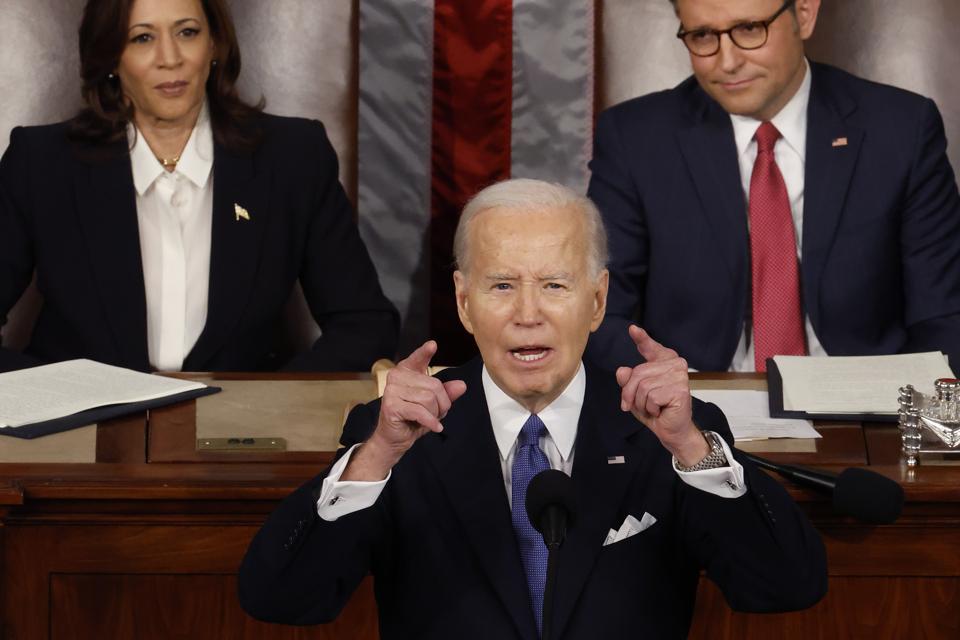Joe Biden’s ambitious State of the Union address called for additional federal spending, regulation and dependency on federal programs, $34 trillion national debt notwithstanding.
Today, Biden followed up his SoTU vision with his $7.3 trillion 2025 fiscal budget proposal. He has clearly not forgotten his “caregiving economy,” American Climate Corps, ample renewable energy projects, environmental justice programs, child care and education programs and other economic and social interventions, such as tax credits for first-time homebuyers.
Of course, presidential budgets are often DOA since, as holder of the purse strings, Congress pushes its own priorities and the GOP has the majority. Plus, Biden’s 2025 proposal arrives with half of fiscal year 2024’s spending still unresolved and a potential partial federal government shutdown looming.
Federal spending growth has been astonishing in recent years. It took until the 1980s for nominal U.S. outlays to reach $1 trillion. Now, interest payments on the debt alone are set to top $870 billion according to the Congressional Budget Office. While Biden projects cutting the deficit by $3 trillion over ten years, the yearly red ink is perpetual.
Unsustainable autopilot spending is a creature of both parties. Not that long ago, the George W. Bush administration saw the first $2 trillion and $3 trillion budgets. The financial crisis in 2008 helped usher in the first $4 trillion budget. The federal reaction to COVID propelled outlays above $6 trillion annually. Now, even without crisis, we are $7 trillion and skybound.
As Biden’s SoTU and new budget proposal make obvious, scaling back plays no part of the administration’s plan. Instead, Biden seeks higher marginal tax rates for corporations and to force the nation’s fewer than 800 billionaires to pay at least 25 percent tax.
Dueling budgets are upon us. On the same day as the SoTU last week, the House Budget Committee marked up its Concurrent Resolution on the Budget for FY 2025 on a party line vote.
The GOP version targets “bloated bureaucracy” and aims at $14 trillion in deficit reduction over 10 years capped with an optimistic projected surplus of $44 billion in fiscal year 2034. The GOP would achieve this downsizing by shaving spending on the likes of the Inflation Reduction Act’s billions in green energy subsides.
Right off the bat, we perceive no standout prospects for agreed-upon downsizing between the two budgetary visions this election year. The administration is committed to the principle that Washington will do better things with all that money than corporations or billionaires; and too often, so is the GOP.
If we squint our eyes, though, we might see some footpaths if not avenues for cooperation that could grow in importance. There does exist some precarious bipartisan overlap in the likes of easing permitting approvals (albeit for different types of infrastructure and energy projects) and for nuclear power and uranium processing.
While both parties emphasize spending, easing regulations like these can benefit the economy and job creation, and in turn reduce the federal budget BMI.
In that vein, while it did not receive much attention, the 86-page GOP budget proposal includes a four-page “Policy Statement on Government Deregulation.”
While this element got criticized as “harmful” by Budget Committee Democrats who dislike the overall spending package and would never go along with the Policy Statement’s “repealing all new regulations created under President Biden,” there happen to be red tape and paperwork streamlining measures noted within those few pages that possess bipartisan appeal, and even roots. These include regulatory budgeting and greater transparency for rules and guidance documents.
The deregulation policy statement’s calls “to examine ways to relieve the burdens of overregulation throughout the Federal Government,” and to “to ensure that once harmful and costly regulations are repealed” are rather unobjectionable.
If policymakers follow through, reducing over-regulation is one element of fostering a healthy economy and resilient, self-reliant households and communities rather than the federal domination sought now. That, and largely only that, can ease spending pressures.
While Biden is fond of saying, “this is America” and there is “nothing beyond our capacity,” balancing the budget seems to be. Biden’s vision of a caretaker federal government and a sweeping regulatory enterprise is simply not compatible with cutting spending.
The last budget surplus occurred under Clinton in 2001. If corporate and middle-class dependency on Washington—boosted by post-pandemic legislation like the aforementioned inflation law and the bipartisan infrastructure legislation—continue as the new normal, the political constituency for budget cuts to correct debt spending will continue to shrink, and things would not end well.
Regaining the capacity for fiscal sanity and addressing spiraling debt involves commitments to downsize agencies and programs and to leave trillions of dollars with the states and localities where basic functions used to be and should be restored.
However budget battles rage, our national motto must not be, “When you run out of other people’s money, keep spending anyway.”
Both parties must take that to heart and streamline federal spending and regulation. Fiscal and regulatory santity cannot be the only things “beyond our capacity.”

